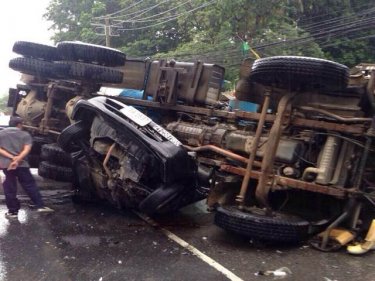The car and the cement truck were both heading along Patak Road over Karon Hill when the double-fatality crash came on a curving section in rain about 5pm.
Little is known about the man and woman at this stage. Their bodies were being extracted late today.
The car carried Bangkok plates and additional Malaysian numbers of the kind assigned when cars are driven across the border.
A pickup skidded into the rear of the flipped concrete truck without additional serious damage being caused.
* It has since been revealed that just one person, Phuket expat Philippe Wagner, 46, from Switzerland, was killed.



.jpg)
.jpg)
.jpg)














How horrible, I hope it was fast. Those cement trucks are notorious for taking up half of the opposite lane around corners - as if they are in a race. You don't dare try to assert your lane position and urge them over, or they may flip over onto you.
Seems every other one doesn't have visible tag numbers, either.
Posted by The Night Mare on June 4, 2014 20:13